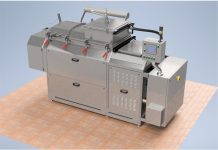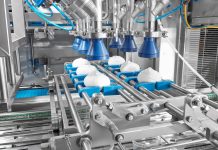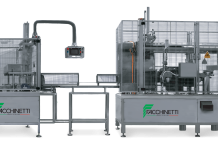The ripening

The cheese coming from the warm rooms is stocked into ripening rooms at 6-8°C with a relative humidity around 85%. In these environmental conditions the Gorgonzola remains for 10 to 15 days, still protected by the belt of slats. In this timeframe the cheese loses humidity, the pH increases and metabolism of the protein begins, addressing the texture and the sensory profi le of the fi nished product. The first part of the ripening ends with the fi rst piercing of the cheese. The support belts are removed, the cheese is turned, washed with cold brine and fi nally pierced with a piercing machine through one of the faces. The piercing machines are equipped with stainless steel needles with a diameter of 4 to 5 mm. The length of the needles is 1-2 cm shorter than the height of the cheese because the hole must not pass completely through the cheese. The right distance between the holes is about 2 cm so the total number of holes should be around 110-120. The piercing is essential to allow oxygen to enter and to enable the development of the moulds that grow along the hole and spread through the cheese mass because of the opening obtained in the warm room. After the piercing the cheeses are moved into ripening rooms set at a lower temperature, 4-6°C, and at a higher humidity, from 90% to 95%. These parameters are important to control the metabolism of the entire microbial fl ora in the cheese, keeping it at a right speed and avoiding uncontrolled activities that could jeopardize the sensory profi le of the fi nished product. From 10 to 15 days after the fi rst piercing, the cheese is turned, washed again and pierced through the other face. The two piercing steps cause a signifi cant change of the protein metabolism. A very important consequence of the protein degradation will be the progressive softening of the texture.

Up to this moment the protein metabolism was due mainly to the action of the endogenous plasmin of the milk and to the residual action of the rennet enzymes. Now the development of Penicillium roqueforti starts and the contribution of the moulds to the ripening becomes increasingly important. A sample collected with a trier can show the beginning of the mycelium development. The enzymatic kit of the mould mycelium causes a progressive and important proteolysis of the casein with production of macro- and micro-peptides, free amino acids and ammonia. These chemical compounds determine a signifi cant modifi cation of the pH value that smoothly increases from the start point of 5.40±0.10 at the fi rst piercing, to about 5.60 at the sixth week. A signifi cant acceleration of the proteins breakdown increases the value to over 6.10 at the end of the minimum ripening time (i.e. 50 days) and to over 6.60 after 68-72 days. Another class of compounds is essential to complete the ripening and defi ne the expected sensory performances of Gorgonzola: the lipids. The metabolism of the lipids from triglycerides to free fatty acids and then to aromatic compounds is mostly due to the enzymes of molds and yeasts, with a little contribution of some lipases present in the rennet. The oxidation and decarboxylation of the fatty acids produce different methyl-ketones, whose contribution to fl avor and taste is defi nitely the most important factor in the sensory profi le.
Final operations
The ripening of Gorgonzola PDO is completed after 60-65 days for the mild type and 90-95 days for the piquant but these time frames may vary depending on the environmental conditions of the ripening rooms and on the specifi c know how and treatments of each producer. 48 hours before cutting and packaging, the cheese wheels are moved into a cold room at 2-3°C to increase their fi rmness and make their handling easier. The cheeses are divided in 2, 4 or 8 parts or pre-packed in small slices of 150-200 g, using classic wire cutters or ultrasonic blade cutters for a better precision in prefi xed weight packs.
by Maurizio Pastore



